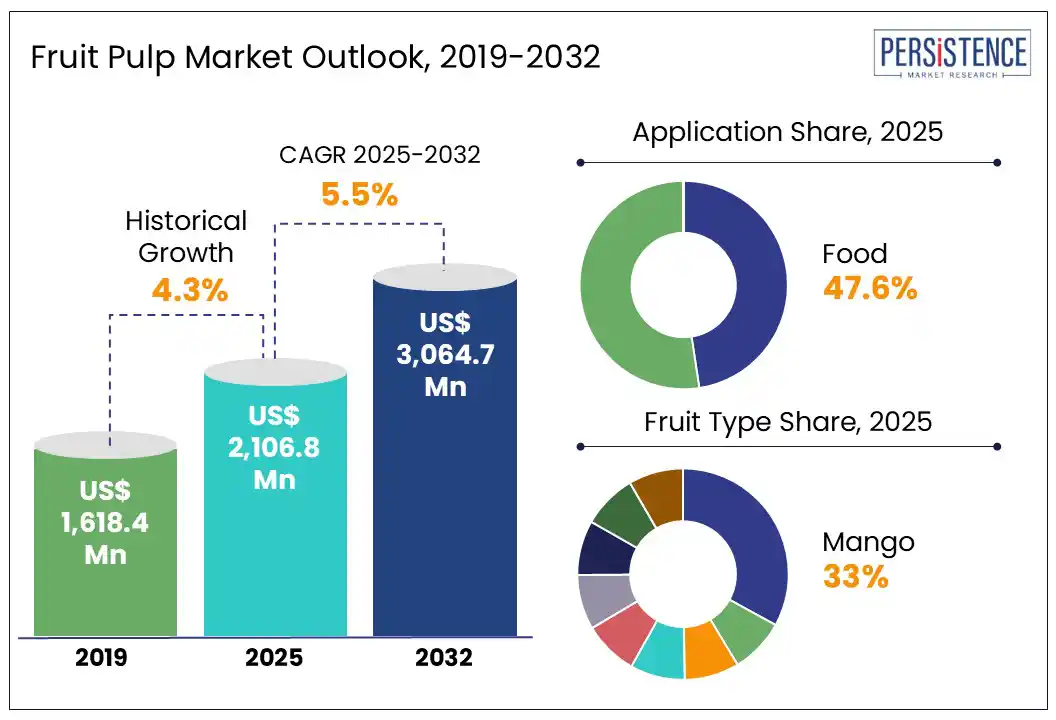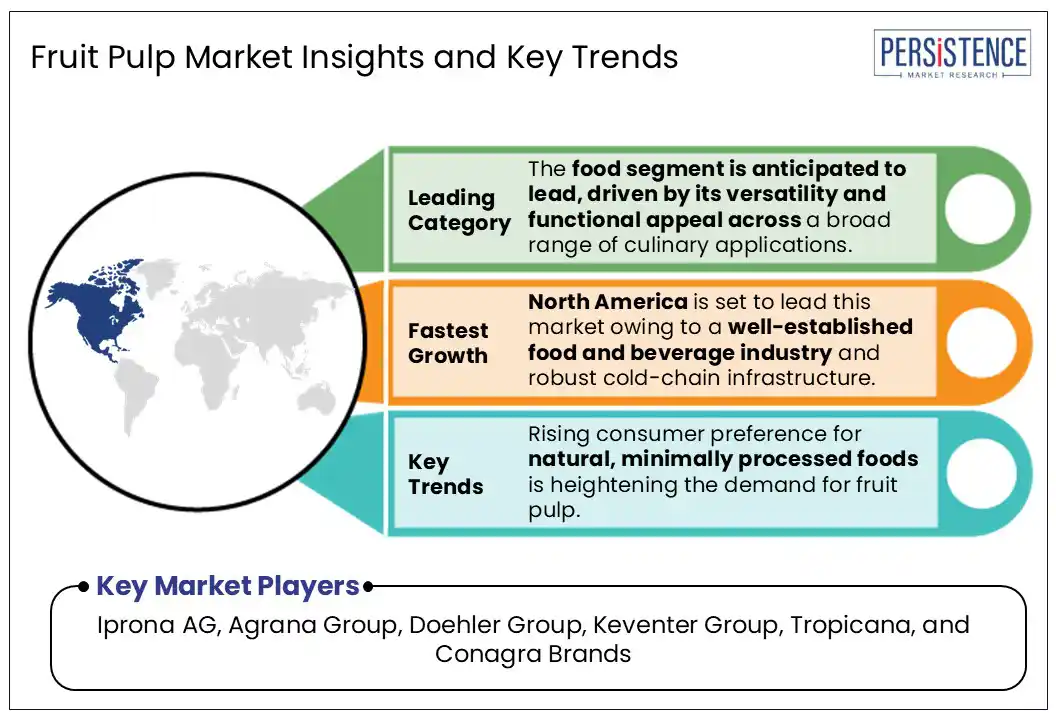ID: PMRREP20215| 166 Pages | 15 Jul 2025 | Format: PDF, Excel, PPT* | Food and Beverages

The global fruit pulp market size is likely to be valued at US$ 2,106.8 Mn in 2025 and is estimated to reach US$ 3,064.7 Mn in 2032, at a CAGR of 5.5% during the forecast period 2025 - 2032.
Fruit pulp is a crushed, strained, and blended food product. It is a highly versatile ingredient used across food and beverage applications, such as smoothies, sauces, jams, and desserts. Fruit pulp preserves the natural flavor, color, and nutritional value of fruits, offering a convenient, ready-to-use form that caters to the growing consumer demand for wholesome, minimally processed food and beverage options. The fruit pulp market growth is driven by the growing demand for natural ingredients and exotic fruit flavors, rising health consciousness, and innovation in food and beverage applications.
As health and wellness trends gain momentum worldwide, fruit pulp has become a favored component in a wide range of applications, particularly beverages, desserts, and packaged foods. The expansion of the beverage industry, especially the ready-to-drink and smoothie segments, continues to fuel the demand for high-quality fruit pulp over artificial concentrates. Further, the growing shift toward organic and sustainably sourced pulp is prompting manufacturers to invest in advanced processing technologies and transparent supply chains. These factors are expected to shape a dynamic and innovation-driven market outlook over the forecast period.

Key Industry Highlights:
|
Global Market Attribute |
Key Insights |
|
Fruit Pulp Market Size (2025E) |
US$ 2,106.8 Mn |
|
Market Value Forecast (2032F) |
US$ 3,064.7 Mn |
|
Projected Growth (CAGR 2025 to 2032) |
5.5% |
|
Historical Market Growth (CAGR 2019 to 2024) |
4.3% |
The rising consumer inclination toward dietary health and wellness is one of the primary drivers of the fruit pulp market growth. As people become increasingly conscious of the impact of diet on long-term well-being, the demand for natural, clean-label products that offer functional benefits without artificial additives is noticeably rising. Fruit pulp, which retains the natural taste and nutritional value of whole fruits, is increasingly utilized in a range of products, such as smoothies, yogurts, baby food, and baked goods. The trend is especially prominent in urban markets, where hectic lifestyles and sedentary habits push consumers to choose convenient yet wholesome options. With food and beverage companies responding to this shift by incorporating fruit pulp into their formulations, the market is expected to witness sustained expansion in the coming years.
Despite their growing demand and consumption, fruit pulps come with a fair share of issues, primarily in the form of logistical and preservation challenges. As a semi-processed perishable product, they require cold storage and careful handling throughout the supply chain to maintain their freshness and nutritional integrity. These requirements can spike transportation and storage costs, especially in regions lacking advanced cold-chain infrastructure. In addition to this, irregular availability of seasonal fruits and inconsistencies in crop yields can further disrupt supply and create price volatility. These factors collectively make it difficult for smaller players to compete with established brands and constrain the market’s ability to scale.
The increasing demand for organic and sustainably sourced food products presents a major opportunity for innovation in the fruit pulp market. As consumers become more environmentally conscious and demand greater transparency in food sourcing and production, brands that offer certified organic or ethically harvested pulp are gaining a veritable competitive edge. This opens doors for producers to invest in cleaner processing technologies, biodegradable packaging, and collaborate with local farmers through fair-trade partnerships. By aligning with eco-conscious consumer values, companies can command premium pricing and build long-term brand loyalty for their products. Additionally, regulatory support for organic labeling and sustainability reporting in many regions further supports the fruit pulp market growth.
By application, this market has been bifurcated into food and beverages. The food segment is anticipated to lead with a share of 47.6% in 2025, driven by its versatility and functional appeal across a broad range of culinary applications. Fruit pulp is extensively used in the production of a variety of foods, such as jams, jellies, bakery fillings, and frozen desserts. Its ability to impart natural sweetness and real fruit flavor makes it a highly preferred ingredient among food companies aiming to meet clean-label and health-conscious consumer expectations.
On the other hand, the beverage segment is the fastest growing over the forecast period, fueled by consumers’ shift toward natural, functional, and clean-label drinks. Another contributing factor is the rise in the demand for on-the-go beverages and premium juice blends, particularly in urban markets. Additionally, innovations in cold-pressed and artisanal drinks are also generating new opportunities for pulp-based formulations.
Based on fruit type, the fruit pulp market has been segmented into mango, apple, guava, banana, pineapple, strawberry, papaya, tomato, and others. Mango pulp dominates this category, accounting for a market share of 33% during the forecast period on account of its extensive use in juices, dairy products, and desserts. Moreover, its massive popularity and strong demand in both domestic and export markets, especially in South Asia and the Middle East, make it a high-value segment.
Strawberry and apple pulp follow closely, having wide applications in ice creams, bakery fillings, smoothies, and baby food. One key driving factor for this segment is the year-round availability of strawberries and apples in temperate regions, which contributes to steady production of these pulps.

North America is set to lead in the forecast period accounting for approximately 28% of the fruit pulp market share, during the forecast period. Its position is attributable to a well-established food and beverage industry, robust cold-chain infrastructure, and a growing consumer demand for natural and clean-label products. The region’s health-conscious population increasingly prefers minimally processed ingredients, driving the use of fruit pulp in everyday as well as special foods and beverages. The trend toward organic and sustainable consumption is also gaining traction in the region, driving manufacturers to source certified organic pulp.
Asia Pacific is the fast-growing in the fruit pulp market, with the primary driving force being the warm, tropical climate in the region that allows for large-scale cultivation of a variety of fruits. Aiding this is the cost-effective production of pulps and the rising demand from both domestic and export markets. Countries such as India, Thailand, and the Philippines are major producers and exporters of mango, guava, and banana pulp. Rapid urbanization and a shift toward packaged, health-oriented food and beverages are further fueling regional consumption. Moreover, government support for food processing industries continues to enhance the region’s growth prospects.
The global fruit pulp market is characterized by intense competition among key players striving to innovate and capture consumer interest. For instance, The Coca-Cola Company has launched several innovative products since 2022, including fruit pulp-infused beverages aimed at health-conscious consumers. Their focus on reducing added sugars while enhancing flavor profiles demonstrates a commitment to meeting evolving consumer preferences.
Nestlé introduced new fruit pulp-based snacks that cater to the growing demand for nutritious, on-the-go options. These innovations reflect a broader market trend toward healthier, more natural ingredients, positioning these companies favorably for future growth.
The fruit pulp market is projected to reach US$ 2,106.8 Mn in 2025.
Rising consumer inclination toward health-conscious foods and beverages is a key market driver.
The fruit pulp market is poised to witness a CAGR of 5.5% from 2025 to 2032.
The increasing demand for organic and sustainably sourced food products presents a major opportunity for innovation.
The key players in the global fruit pulp market include Iprona AG, Agrana Group, and Doehler Group.
|
Report Attribute |
Details |
|
Historical Data/Actuals |
2019 - 2024 |
|
Forecast Period |
2025 - 2032 |
|
Market Analysis Units |
Value: US$ Mn |
|
Geographical Coverage |
|
|
Segmental Coverage |
|
|
Competitive Analysis |
|
|
Report Highlights |
|
|
Customization and Pricing |
Available upon request |
By Fruit Type
By Distribution
By Application
By Region
Delivery Timelines
For more information on this report and its delivery timelines please get in touch with our sales team.
About Author